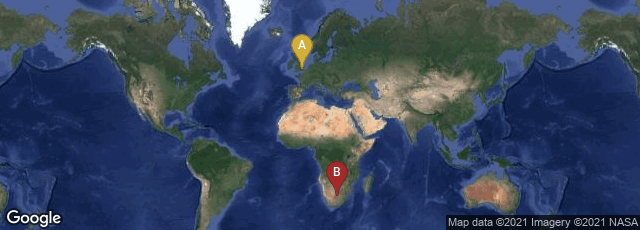
A: London, England, United Kingdom, B: North West, South Africa
In 1871 Charles Darwin published a 2-volume work entitled The Descent of Man, and Selection in Relation to Sex. Twelve years after the publication of On the Origin of Species, Darwin made good his promise to “throw light on the origin of man and his history” by publishing The Descent of Man in which he compared man’s physical and psychological traits to similar ones in apes and other animals, and showed how even man’s mind and moral sense could have evolved through processes of natural selection.
In discussing man’s ancestry, Darwin did not claim that man was directly descended from apes as we know them today, but stated that the extinct ancestors of Homo sapiens would have to be classed among the primates. This statement was widely misinterpreted by the popular press, and caused a furor second only to that raised by the Origin. Darwin also added an essay on sexual selection, i.e. the preferential chances of mating that some individuals of one sex have over their rivals because of special characteristics, leading to the accentuation and transmission of those characteristics.
Darwin originated of the single-origin hypothesis in paleoanthropology.
"In paleoanthropology, the recent African origin of modern humans is the mainstream model describing the origin and early dispersal of anatomically modern humans. The theory is called the (Recent) Out-of-Africa model in the popular press, and academically the recent single-origin hypothesis (RSOH), Replacement Hypothesis, and Recent African Origin (RAO) model. The hypothesis that humans have a single origin (monogenesis) was published in Charles Darwin's Descent of Man (1871). The concept was speculative until the 1980s, when it was corroborated by a study of present-day mitochondrial DNA, combined with evidence based on physical anthropology of archaic specimens" (Wikipedia article on Recent African origin of modern humans, accessed 05-15-2010).
Darwin wrote in a section of The Descent of Man entitled "On the Birthplace and Antiquity of Man":
"In each great region of the world the living mammals are closely related to the extinct species of the same region. It is, therefore, probable that Africa was formerly inhabited by extinct apes closely allied to the gorilla and chimpanzee; and as these two species are now man's nearest allies, it is somewhat more probable that our early progenitors lived on the African continent than elsewhere. But it is useless to speculate on this subject, for an ape nearly as large as a man, namely the Dryopithecus of Lartet, which was closely allied to the anthropomorphous Hylobates, existed in Europe during the Upper Miocene period; and since so remote a period the earth has certainly undergone many great revolutions, and there has been ample time for migration on the largest scale."
In spite of Darwin's suggestion, few if any 19th century researchers on human origins searched in Africa for evidence. It was not until Raymond Dart's highly controversial discovery of the first African hominin (hominid), Australopithecus africanus, in 1925 that serious attention began to paid to the African origins of mankind.